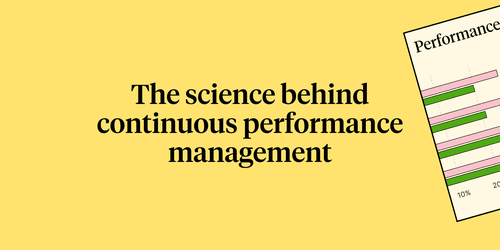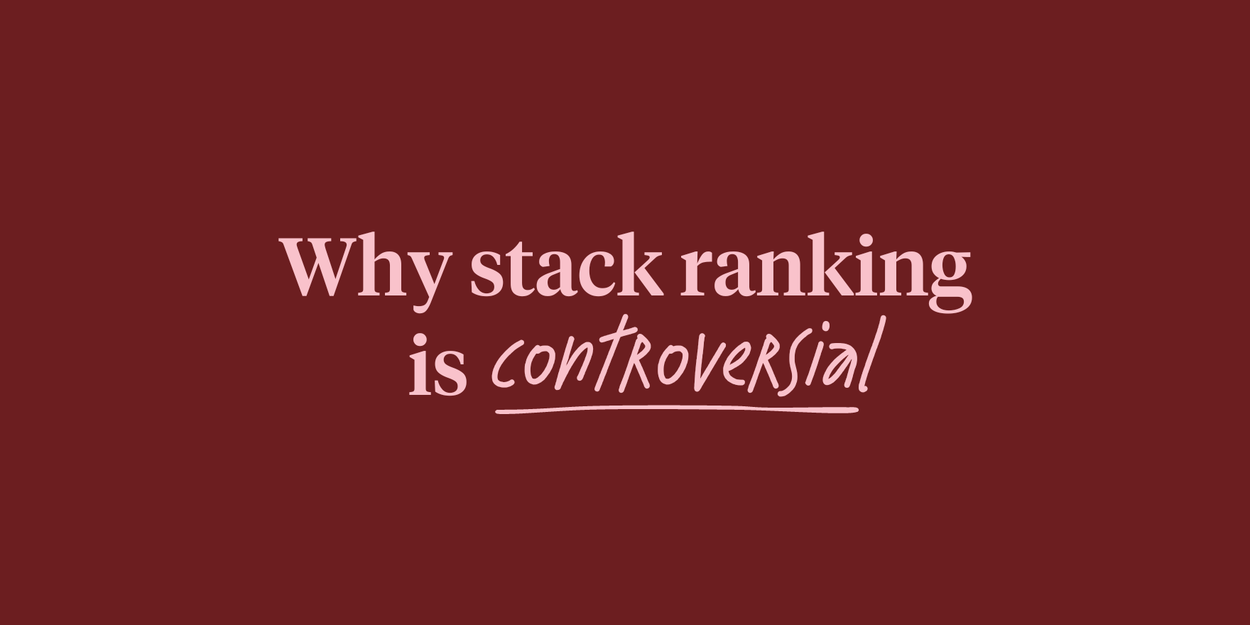
Stack ranking: What it is and why it’s controversial

Every company wants a high-performing workforce. It’s figuring out how to get there that feels tricky. How do you make employees hungry to achieve and excel?
What if you identified your lowest performers (for example, the bottom 10% of your staff) and let them go? Surely, that would demonstrate that you’re serious about performance and instill greater motivation to exceed expectations, right?
If you’re wincing a bit, we don’t blame you. It sounds merciless and potentially even misguided. But that’s exactly the premise behind a well-known and controversial performance management system: stack ranking.
What is stack ranking?
Stack ranking (also known as rank and yank) is an approach to performance management where companies rate employees against their coworkers. Created in the 1980s by Jack Welch, former CEO of General Electric, stack ranking involves sorting employees into three categories:
- Exemplary
- Meeting expectations
- In need of improvement
But here’s where things get more competitive: Everybody can’t be a winner. You need to have a fixed number or percentage of employees in each category. For example, 15% high performers, 70% meeting expectations, and 15% low performers is a common breakdown.
The original method used percentages, but this ranking system can take different forms. In another style of stack ranking, leaders assign numbers to employees. Someone who leads a team of 25 is asked to rank them from one (best performer) to 25 (worst performer) during the performance review cycle.
This approach forces leaders to be rigorous and make the hard decisions – they can only label a limited number of people as top performers, and they’re required to identify people who aren’t pulling their weight. For that reason, you might hear stack ranking referred to as forced ranking, forced distribution, or a vitality curve (as a reference to the bell curve employees are ranked on).
So, once you’ve determined which employees fall into each category, what do you do with that information? If you stick with Welch’s original concept, the bottom percentage of performers is identified – and then removed from the organization. Fired. Let go. Shown the door. Stack ranking is also called “rank and yank,” meaning you pinpoint low-performing employees and then cut them loose.
Welch argued that stack ranking was an efficient way for leaders to remove the dead weight and keep their top contributors – or, at the very least, employees who are satisfactory.
It sounds ruthless (and honestly, it is), but it was a surprisingly prominent system throughout the 80s, 90s, and early 2000s. Outside of GE, large companies like Amazon, Walmart, Microsoft, and Google all reportedly used the approach at different times.
What are the pros and cons of stack ranking?
First, let’s make one thing clear: Stack ranking is no longer a recommended approach. As company culture and employee wellbeing have gained importance, most experts agree that this type of merciless and inflexible system does more harm than good.
But with that said, stack ranking is controversial for a reason – there are still plenty of proponents who argue it’s one of the most effective ways to light a fire under employees.
It’s always worth exploring an issue from both sides, so let’s take a look at some of the commonly cited pros and cons of stack ranking.
Pros of stack ranking
- Clarity: While stack ranking is pretty harsh, it’s also unmistakable. Leaders and employees know where they stand – there’s no guesswork or ambiguity.
- Critical thinking: Tough decisions are…well, tough. That’s probably why only 20% of organizations excel at decision-making. This system gives managers a defined framework to separate their low performers from their high performers. For leaders who tend to avoid hard conversations, stack ranking is a push to draw firm conclusions.
- Motivation: Science says that humans are competitive. So, matching employees up against each other can boost their motivation, especially for the ones who realize they’re lagging behind and are potentially on the chopping block.
Cons of stack ranking:
- Competition: Pitting people against each other offers a bit of a kick, but it also fuels competition, mistrust, and a toxic culture. All of that detracts from employees’ overall wellbeing, which is a priority for many companies today.
- Burnout: The dog-eat-dog environment that stack ranking promotes is stressful and draining for employees, which can increase burnout. McKinsey research shows that toxic workplace behaviors are the single biggest predictor of burnout symptoms.
- Lack of individuality: With stack ranking, employee performance is managed based on other people – not based on an employee’s unique motivators, performance standards, goals, and strengths. Using other people as a benchmark isn’t a reliable way to support employees and pull the best out of them.
- Bias: Stack ranking feels black and white, but it’s normal for humans to show a preference for people who remind them of themselves. This rigid ranking system may encourage bias and favoritism.
- Turnover: From fostering a cutthroat culture to neglecting employees’ individual career ambitions, it makes sense that stack ranking could nudge workers toward the door. The same McKinsey research found that toxic workplace behaviors are also the biggest predictor of an employee’s intent to leave.
When should you use stack ranking?
There are undoubtedly more drawbacks than advantages to this approach. And again, the consensus among workplace experts is that ranking employees is both archaic and damaging. When companies are increasingly focused on innovation and collaboration, a callous system like stack ranking can quickly sabotage those values.
So, is there ever a time when stack ranking is the answer? In specific circumstances, this sort of uncompromising and unambiguous approach could be helpful, such as when you need to recognize a limited number of high performers with a bonus or award.
But it’s also worth noting that even that is an adaptation of the original model. You’re not categorizing employees and slashing the bottom percentile – you’re using the system to get more clarity about who falls where to make decisions that don’t result in termination.
What can you do instead of stack ranking?
In the vast majority of situations, true stack ranking isn’t the best way to inspire employees to achieve their full potential. That raises the question: What should you do instead?
Our recommendation is continuous performance management, which embeds the performance process into daily work. Rather than engaging in performance conversations or evaluations once or twice a year, employees get regular, ongoing feedback. This means they always have an up-to-date understanding of where they excel and where they need to improve.
With stack ranking, you’re simply mandating high performance with threats and competition. But with continuous performance management, you’re showing employees that you understand their individual career ambitions and want to equip them with the guidance, support, and resources they need to get there.
Take the pressure out of high performance
On the surface, stack ranking makes sense. Naturally, employees will feel more inclined to exceed expectations when the stakes are high.
But at the end of the day, you don’t want employees to put in the work because they’re worried that their jobs are on the line. You want them to feel intrinsically motivated to do their best work in an organization that’s supportive, empowering, and aligned with their goals and values. Tools like Perform by Culture Amp make this easier by providing all the capabilities you need to institute more engaging, continuous performance management, such as:
- Goal-setting that is aligned with organizational goals and driven by the employee
- 1-on-1s that are regular, science-backed, and foster connection
- Anytime feedback that is easy to give and receive
- Performance calibrations to ensure your assessments are fair and objective
Your employees are more than just a number. But rating and ranking them is a surefire way to make them feel like one.




